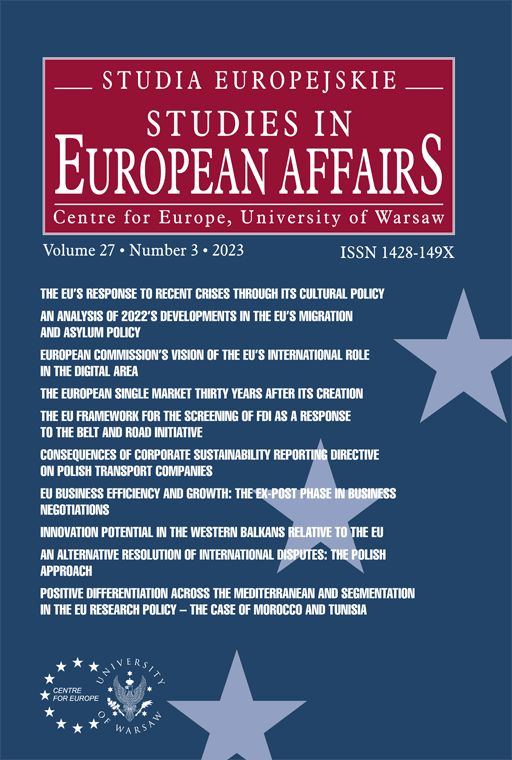
ISSUE: 3/2023
- Volume 27
- Number 3
- 2023
Subscribe NEWSLETTER
Studia Europejskie –
Studies in European Affairs
ISSN: 1428-149X
e-ISSN: 2719-3780
License
Articles published in the journal are under a Creative Commons Attribution – Non Commercial – No Derivatives 4.0 International License
Possible Consequences of Corporate Sustainability Reporting Directive on Polish Transport Companies
Abstract
Over the past 2 or 3 years, the European Commission has been gradually introducing further regulations with the ultimate goal of establishing European standards for Environmental Social and Governance (ESG) reporting. The aim of this paper is to discuss the regulations contained in the recently adopted Corporate Sustainability Reporting Directive (CSRD), which became effective in January 2023 and to provide a deeper understanding of the distinctive characteristics of Polish transport companies and their value chain relationships with other entities. As an introduction to the main provisions of the recently introduced CSRD, the authors will first outline its core principles. They will then present the fundamental issues related to the value and supply chain and the European Commission’s (EC) newly introduced notion of the chain of activities. The article concludes with recommendations for companies.
In order to achieve the research objective, the article uses quantitative and qualitative research methods. Statistical methods point to the importance of Polish transport companies in the European Union. Qualitative methods were used to review legislative documents of the European Union related to this topic.
Our findings contribute to growing, but still limited literature on European regulations in the area of ESG reporting and impact of these regulations on companies.
References
Badyda, A.J. (2010) „Zagrożenia środowiskowe ze strony transportu”, Nauka. Vol. 4, pp. 115–125.
Borowski, J. (2013) “Łańcuch wartości jako nowa teoria zarządzania strategicznego”, Optimum. Studia Ekonomiczne. Vol. 2(62), pp. 11–25. DOI: https://doi.org/10.15290/ose.2013.02.62.02.
Carter, C.R. and Rogers, D.S. (2008) “A framework of sustainable supply chain management: moving toward new theory”, International Journal of Physical Distribution & Logistics Management. Vol. 38(5), pp. 360–387, DOI: https://doi.org/10.1108/09600030810882816.
Christopher, M. (1998) Logistics and Supply Chain Management – Strategies for reducing cost and improving service, 2nd ed. London: Financial Times/Pitman Publishing. DOI: https://doi.org/10.1080/13675569908901575.
Cichosz., M. (2020) Drony w logistyce ostatniej mili – innowacja wspierająca zrównoważoną logistykę in Zagrajek, P. (ed.) Sektor lotniczy w erze transformacji społecznej i technologicznej: monografia dedykowana prof. Elżbiecie Marciszewskiej. Warsaw: SGH, pp. 415–430.
Ciliberti, F., Pontrandolfo, P. and Scozzi, B., (2008) “Logistics social responsibility: Standard adoption and practices in Italian companies”, International Journal of Production Economics. Vol. 113(1), pp. 88–106. DOI: https://doi.org/10.1016/j.ijpe.2007.02.049.
Clementino, E. and Perkins, R. (2021) “How Do Companies Respond to Environmental, Social and Governance (ESG) ratings? Evidence from Italy”. Journal of Business Ethics, Vol. 171(2), pp. 379–397. DOI: https://doi.org/10.1007/s10551-020-04441-4.
Directive (EU) 2022/2464 of the Parliament and of the Council. Official Journal of the European Union. Available at: https://eur-lex.europa.eu/legal-content/EN/TXT/?uri=CELEX:32022L2464 (Access 20.06.2023).
Directorate-General for Mobility and Transport of European Commission (2022). EU transport in figures. Statistical pocketbook.
Luxembourg. Available at: https://op.europa.eu/en/publication-detail/-/publication/f656ef8e-3e0e-11ed-92ed-01aa75ed71a1 (Access 20.06.2023).
EEA (2021) “Exposure of Europe’s population to environmental noise”. Available at: https://www.eea.europa.eu/ims/exposure-of-europe2019s-population-to-noise (Access 20.06.2023).
EEA (2022) “Transport and Environment Report 2022”. Available at: https://www.eea.europa.eu//publications/transport-and-environment-report-2022 (Access 20.06.2023).
Elkington, J. (1998) Cannibals with Forks: The Triple Bottom Line of the 21st Century. Stoney Creek: New Society Publishers.
European Commission (2023) Corporate sustainability reporting. European Commission. Available at: https://finance.ec.europa.eu/capital-markets-union-and-financial-markets/company-reporting-and-auditing/company-reporting/corporate-sustainability-reporting_en (Access 20.06.2023).
European Parliament and European Council (2014) Directive 2014/95/EU of the European Parliament and of the Council (No. L 330/1). Official Journal of the European Union: Official Journal of the European Union. Available at: https://eur-lex.europa.eu/legal-content/EN/TXT/?uri=CELEX:32014L0095 (Access 20.06.2023).
European Parliament and European Council (2022). Directive (EU) 2022/2464 of the Parliament and of the Council. Official Journal of the European Union: Official Journal of the European Union. Available at: https://eur-lex.europa.eu/legal-content/EN/TXT/?uri=CELEX:32022L2464 (Access 20.06.2023).
Frankowska, M. (2015) „Łańcuch logistyczny, łańcuch dostaw i łańcuch wartości – próba usystematyzowania koncepcji”, Problemy Transportu i Logistyki. Vol. 31, pp. 77–91. DOI: https://doi.org/10.18276/ptl.2015.31-05.
Houlihan, J.B. (1988) “International Supply Chains: A New Approach”, Management Decision. Vol. 26(3), pp. 13–19. DOI: https://doi.org/10.1108/eb001493.
IATA (2021) Fly net zero. Available at: https://www.iata.org/en/programs/environment/flynetzero/ (Access 20.06.2023).
Kippenberger, T. (1997) „The value chain: the original breakthrough”, The Antidote. Vol. 2(5), pp. 7–10. DOI: https://doi.org/10.1108/EUM0000000006430.
Koźlak, A. (2012) Nowoczesny system transportowy jako czynnik rozwoju regionów w Polsce. Gdańsk: Wydawnictwo Uniwersytetu Gdańskiego.
Kuźnar, A. (2017) „Udział Polski w globalnych łańcuchach wartości”, Horyzonty Polityki. Vol. 8(22), pp. 49–67. DOI: https://doi.org/10.17399/HP.2017.082203.
Mejías, A.M., Paz, E. and Pardo, J.E. (2016) “Efficiency and sustainability through the best practices in the Logistics Social Responsibility framework”, International Journal of Operations & Production Management. Vol. 36(2), pp. 164–199. DOI: https://doi.org/10.1108/IJOPM-07-2014-0301.
Pawłowska, B. (2017) An overview of the progress towards sustainable transport development by using TERM indicators in Suchanek, M. (ed.) Sustainable transport development innovation and technology. Proceedings of the 2016 TranSopot Conference. Spronger, pp. 27–46.
Pawłowska, B. (2018) “External costs of transport in Poland”. Scientific Review – Engineering and Environmental Sciences. Vol. 27(1), pp. 28–41.
Porter, M.E. (2001) Porter o konkurencji. Warszawa: Polskie Wydawnictwo Ekonomiczne.
Porter, M.E. (2006) Przewaga konkurencyjna. Osiąganie i utrzymywanie lepszych wyników. Gliwice: Helion.
Saeed, M.A. and Kersten, W. (2017) “Supply chain sustainability performance indicators: A content analysis based on published standards and guidelines”, Logistics Research. Vol. 10(12), pp. 1–19. DOI: https://doi.org/10.23773/2017_12.
Sipiczki, A. (2022) “A Crticial Look at the ESG Market”. CEPS Policy Insights (15). Available at: https://www.sipotra.it/wp-content/uploads/2022/05/A-CRITICAL-LOOK-AT-THE-ESG-MARKET.pdf (Access 20.06.2023).
Stadtler, H. (2004) Supply Chain Management – An Overview in Stadtler, H. and Kilger, Ch. (ed.) Supply Chain Management and Advanced Planning. Berlin: Springer, pp. 9–36. DOI: https://doi.org/10.1007/978-3-540-74512-9_2.
Stevens, G.C. (1989) “Integrating the Supply Chain”, International Journal of Physical Distribution & Materials Management. Vol. 19(8), pp. 3–8. DOI: https://doi.org/10.1108/EUM0000000000329.
DOI: 10.33067/SE.3.2023.6
Language: English
Pages: 105-119
How to Cite:
Harvard
Borowicz, A. and Czerepko, J. (2023) "Possible Consequences of Corporate Sustainability Reporting Directive on Polish Transport Companies". Studia Europejskie – Studies in European Affairs, 3-2023, pp. 105-119. DOI: 10.33067/SE.3.2023.6